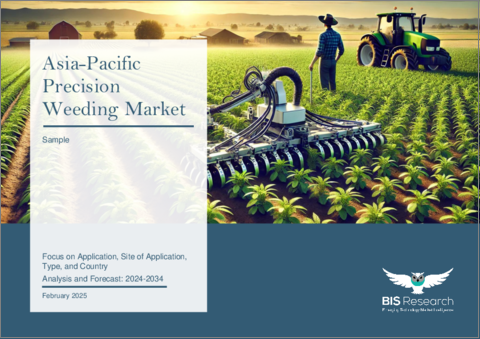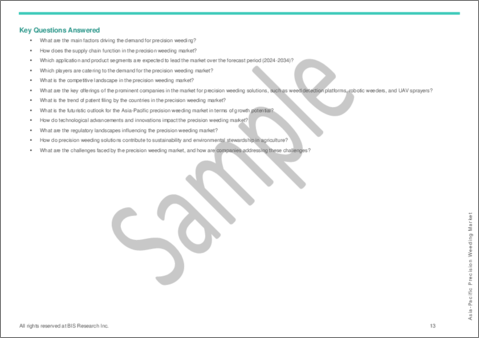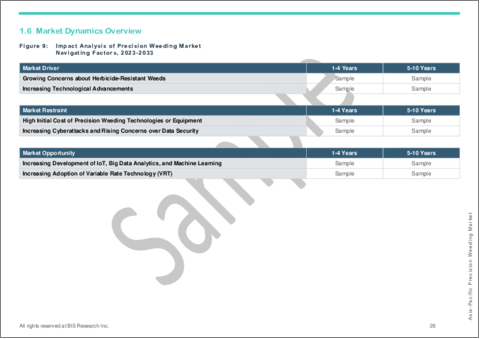|
|
市場調査レポート
商品コード
1661672
アジア太平洋地域の精密除草市場:用途・適用サイト・タイプ・国別の分析・予測 (2024-2034年)Asia-Pacific Precision Weeding Market: Focus on Application, Site of Application, Type, and Country - Analysis and Forecast, 2024-2034 |
||||||
カスタマイズ可能
|
|||||||
| アジア太平洋地域の精密除草市場:用途・適用サイト・タイプ・国別の分析・予測 (2024-2034年) |
|
出版日: 2025年02月26日
発行: BIS Research
ページ情報: 英文 80 Pages
納期: 1~5営業日
|
全表示
- 概要
- 図表
- 目次
アジア太平洋地域の精密除草の市場規模は、2024年の3億4,420万米ドルから、予測期間中は14.90%のCAGRで推移し、2034年には13億8,000万米ドルに達すると予測されています。
アジア太平洋地域の精密除草市場は、持続可能な農業と作物収量の増加に対する需要の高まりにより急速に拡大しています。AI、ロボット工学、機械学習などの最先端技術は、正確な識別と除去を可能にし、除草剤の使用量を減らし、環境への影響を最小限に抑えることで、雑草管理に革命をもたらしています。自律型ロボットやスマート散布機などの精密除草システムは、センサーや画像技術を使用して作物と雑草を区別し、的を絞った環境に優しい雑草管理を実現します。アジア太平洋地域では、除草剤抵抗性の高まり、労働力不足、持続可能な農業を支援する規制イニシアティブの結果、市場が拡大しています。さらに、政府の支援、農業技術新興企業への投資、自動化の進展が市場の成長を促進しています。アジア太平洋地域の農業がよりスマートで持続可能なソリューションにシフトするにつれ、精密除草は近代的な農法における重要な要素になると考えられています。
| 主要市場統計 | |
|---|---|
| 予測期間 | 2024-2034年 |
| 2024年評価 | 3億4,420万米ドル |
| 2034年予測 | 13億8,000万米ドル |
| CAGR | 14.9% |
除草剤耐性、人件費の増大、精密農業を支援する政府プログラムなどが、アジア太平洋地域の市場成長を促進する要因の一部です。持続可能性と生産性を高めるため、中国、日本、オーストラリアなどの国々は農業技術革新に投資しています。また、自動化に対する支援の高まりや、農業技術を開発する新興企業に対する資本の増加も、開発を加速させています。精密農業が普及するにつれ、精密除草は同地域の農業部門を近代化し、長期的な効率と持続可能性を確保する上で重要な役割を果たすようになります。
当レポートでは、世界の油田用化学品の市場を調査し、主要動向、市場影響因子の分析、法規制環境、技術開発・特許の動向、ケーススタディ、市場規模の推移・予測、各種区分・主要国別の詳細分析、競合情勢、主要企業のプロファイルなどをまとめています。
市場の分類
セグメンテーション1:用途別
- 農業
- 穀物・穀類
- 液果類・野菜
- 油糧種子・豆類
- 果樹・ブドウ園
- 非農業
セグメンテーション2:適用場所別
- 露地
- 環境管理型農業
セグメンテーション3:タイプ別
- 雑草検出プラットフォーム
- 雑草管理
- ロボット除草機
- ドローンまたはUAV散布機
- 統合レトロフィット技術
セグメンテーション4:地域別
- 中国、インド、日本、韓国、その他
目次
エグゼクティブサマリー
範囲と定義
第1章 市場
- 動向:現在および将来の影響評価
- 精密除草市場を形成する動向
- 自動化・制御システムの拡張
- ドローンと衛星画像の利用増加
- サプライチェーンの概要
- バリューチェーン分析
- マーケットマップ
- 価格予測
- 研究開発レビュー
- 特許出願動向 (国別・企業別)
- 規制状況
- ステークホルダー分析
- 使用事例
- エンドユーザーと購入基準
- 市場力学の概要
- 市場促進要因
- 市場の課題
- 市場機会
第2章 地域
- 地域別概要
- アジア太平洋
- アジア太平洋の主要参入企業
- 市場成長の原動力
- 市場課題
- 用途
- 製品
第3章 市場:競合ベンチマーキングと企業プロファイル
- 次なるフロンティア
- 競合情勢
- 企業プロファイル
- XAG Co., Ltd.
第4章 調査手法
List of Figures
- Figure 1: Asia-Pacific Precision Weeding Market (by Application), $Million, 2024, 2030, and 2034
- Figure 2: Asia-Pacific Precision Weeding Market (by Site of Application, $Million, 2024, 2030, and 2034
- Figure 3: Asia-Pacific Precision Weeding Market (by Type), $Million, 2024, 2030, and 2034
- Figure 4: Key Events
- Figure 5: Supply Chain Analysis for Precision Weeding Market
- Figure 6: Pricing Forecast of Precision Weeding Market $/Unit, 2023-2034
- Figure 7: Patent Filed (by Country), January 2020-July 2024
- Figure 8: Patent Filed (by Company), January 2020-July 2024
- Figure 9: Impact Analysis of Precision Weeding Market Navigating Factors, 2023-2033
- Figure 10: Major Technical Application Domains of Big Data and Machine Learning in Agriculture
- Figure 11: China Precision Weeding Market, $Million, 2023-2034
- Figure 12: Japan Precision Weeding Market, $Million, 2023-2034
- Figure 13: India Precision Weeding Market, $Million, 2023-2034
- Figure 14: South Korea Precision Weeding Market, $Million, 2023-2034
- Figure 15: Rest-of-Asia-Pacific Precision Weeding Market, $Million, 2023-2034
- Figure 16: Strategic Initiatives, January 2020-June 2024
- Figure 17: Share of Strategic Initiatives, January 2020-June 2024
- Figure 18: Data Triangulation
- Figure 19: Top-Down and Bottom-Up Approach
- Figure 20: Assumptions and Limitations
List of Tables
- Table 1: Market Snapshot
- Table 2: Opportunities
- Table 3: Overview of Precision Agriculture Technology Areas, Key Innovations, Benefits/Limitations, and Future Outlooks
- Table 4: Reported Malware Attacks on Food and Agricultural Industry, 2020-2023
- Table 5: Precision Weeding Market (by Region), $Million, 2023-2034
- Table 6: Asia-Pacific Precision Weeding Market (by Application), $Million, 2023-2034
- Table 7: Asia-Pacific Precision Weeding Market (by Agriculture), $Million, 2023-2034
- Table 8: Asia-Pacific Precision Weeding Market (by Site of Application), $Million, 2023-2034
- Table 9: Asia-Pacific Precision Weeding Market (by Type), $Million, 2023-2034
- Table 10: Asia-Pacific Precision Weeding Market (by Weed Management), $Million, 2023-2034
- Table 11: Asia-Pacific Precision Weeding Market (by Robotic Weeder), $Million, 2023-2034
- Table 12: China Precision Weeding Market (by Application), $Million, 2023-2034
- Table 13: China Precision Weeding Market (by Agriculture), $Million, 2023-2034
- Table 14: China Precision Weeding Market (by Site of Application), $Million, 2023-2034
- Table 15: China Precision Weeding Market (by Type), $Million, 2023-2034
- Table 16: China Precision Weeding Market (by Weed Management), $Million, 2023-2034
- Table 17: China Precision Weeding Market (by Robotic Weeder), $Million, 2023-2034
- Table 18: Japan Precision Weeding Market (by Application), $Million, 2023-2034
- Table 19: Japan Precision Weeding Market (by Agriculture), $Million, 2023-2034
- Table 20: Japan Precision Weeding Market (by Site of Application), $Million, 2023-2034
- Table 21: Japan Precision Weeding Market (by Type), $Million, 2023-2034
- Table 22: Japan Precision Weeding Market (by Weed Management), $Million, 2023-2034
- Table 23: Japan Precision Weeding Market (by Robotic Weeder), $Million, 2023-2034
- Table 24: India Precision Weeding Market (by Application), $Million, 2023-2034
- Table 25: India Precision Weeding Market (by Agriculture), $Million, 2023-2034
- Table 26: India Precision Weeding Market (by Site of Application), $Million, 2023-2034
- Table 27: India Precision Weeding Market (by Type), $Million, 2023-2034
- Table 28: India Precision Weeding Market (by Weed Management), $Million, 2023-2034
- Table 29: India Precision Weeding Market (by Robotic Weeder), $Million, 2023-2034
- Table 30: South Korea Precision Weeding Market (by Application), $Million, 2023-2034
- Table 31: South Korea Precision Weeding Market (by Agriculture), $Million, 2023-2034
- Table 32: South Korea Precision Weeding Market (by Site of Application), $Million, 2023-2034
- Table 33: South Korea Precision Weeding Market (by Type), $Million, 2023-2034
- Table 34: South Korea Precision Weeding Market (by Weed Management), $Million, 2023-2034
- Table 35: South Korea Precision Weeding Market (by Robotic Weeder), $Million, 2023-2034
- Table 36: Rest-of-Asia-Pacific Precision Weeding Market (by Application), $Million, 2023-2034
- Table 37: Rest-of-Asia-Pacific Precision Weeding Market (by Agriculture), $Million, 2023-2034
- Table 38: Rest-of-Asia-Pacific Precision Weeding Market (by Site of Application), $Million, 2023-2034
- Table 39: Rest-of-Asia-Pacific Precision Weeding Market (by Type), $Million, 2023-2034
- Table 40: Rest-of-Asia-Pacific Precision Weeding Market (by Weed Management), $Million, 2023-2034
- Table 41: Rest-of-Asia-Pacific Precision Weeding Market (by Robotic Weeder), $Million, 2023-2034
- Table 42: Market Share (by Drone or UAV Sprayer), 2023
Introduction to Asia-Pacific Precision Weeding Market
The Asia-Pacific precision weeding market is projected to reach $1,380.0 million by 2034 from $344.2 million in 2024, growing at a CAGR of 14.90% during the forecast period of 2024-2034. The APAC Precision Weeding Market is expanding rapidly due to the growing demand for sustainable agriculture and higher crop yields. Cutting-edge technologies such as artificial intelligence (AI), robotics, and machine learning are revolutionizing weed management by enabling precise identification and removal, reducing herbicide usage, and minimizing environmental impact. Precision weeding systems, such as autonomous robots and smart sprayers, use sensors and imaging technology to distinguish between crops and weeds, ensuring targeted and environmentally friendly weed control. The market is growing in APAC as a result of growing herbicide resistance, labor shortages, and regulatory initiatives supporting sustainable farming. Additionally, government support, investment in agri-tech startups, and automation advancements are driving market growth. As APAC agriculture shifts toward smarter, more sustainable solutions, precision weeding is set to become a key component in modern farming practices.
Market Introduction
| KEY MARKET STATISTICS | |
|---|---|
| Forecast Period | 2024 - 2034 |
| 2024 Evaluation | $344.2 Million |
| 2034 Forecast | $1,380.0 Million |
| CAGR | 14.9% |
Precision weeding reduces the need for herbicides and lessens the impact on the environment by precisely identifying and eliminating weeds using cutting-edge technologies like artificial intelligence (AI), robotics, and machine learning. Targeted weed control is made possible by autonomous weeding robots and smart sprayers with sensors and imaging systems, which increase efficiency over conventional techniques.
Herbicide resistance, growing labor costs, and government programs supporting precision agriculture are some of the factors driving market growth in APAC. To increase sustainability and productivity, nations like China, Japan, and Australia are investing in agri-tech innovations. Adoption is also being accelerated by rising support for automation and more capital for startups developing agricultural technologies. As precision farming gains traction, precision weeding is poised to play a crucial role in modernizing APAC's agricultural sector, ensuring long-term efficiency and sustainability.
Market Segmentation
Segmentation 1: by Application
- Agriculture
- Cereals and Grains
- Berries and Vegetables
- Oilseeds and Pulses
- Orchard and Vineyards
- Non-Agriculture
Segmentation 2: by Site of Application
- Open Field
- Controlled-Environmental Agriculture
Segmentation 3: by Type
- Weed Detection Platform
- Weed Management
- Robotic Weeder
- Drone or UAV Sprayer
- Integrated Retrofit Technology
Segmentation 4: by Region
- Asia-Pacific - China, India, Japan, South Korea, and Rest-of-Asia-Pacific
How can this report add value to an organization?
Product/Innovation Strategy: The product segment helps the reader understand the different precision weeding equipment and solutions. Moreover, the study provides the reader with a detailed understanding of the APAC precision weeding market. Furthermore, there is a growing demand for reliable and cost-effective precision weeding. Manufacturers can seize opportunities to design and produce next-generation precision weeding equipment.
Growth/Marketing Strategy: The Asia-Pacific precision weeding market has seen major development by key players operating in the market, such as business expansions, partnerships, collaborations, mergers and acquisitions, and joint ventures. The favored strategy for the companies has been product developments, business expansions, and acquisitions to strengthen their position in the APAC precision weeding market.
Competitive Strategy: Key players in the Asia-Pacific precision weeding market analyzed and profiled in the study involve precision weeding manufacturers and the overall ecosystem. Moreover, a detailed competitive benchmarking of the players operating in the APAC precision weeding market has been done to help the reader understand how players stack against each other, presenting a clear market landscape. Additionally, comprehensive competitive strategies such as partnerships, agreements, acquisitions, and collaborations will aid the reader in understanding the untapped revenue pockets in the market.
Table of Contents
Executive Summary
Scope and Definition
1 Markets
- 1.1 Trends: Current and Future Impact Assessment
- 1.1.1 Trends Shaping Precision Weeding Market
- 1.1.2 Expansion of Automation and Control Systems
- 1.1.3 Increasing Use of Drones and Satellite Imagery
- 1.2 Supply Chain Overview
- 1.2.1 Value Chain Analysis
- 1.2.2 Market Map
- 1.2.2.1 Precision Weeding Market - Product (by Type)
- 1.2.2.1.1 Weed Detection Platform
- 1.2.2.1.2 Weed Management
- 1.2.2.1 Precision Weeding Market - Product (by Type)
- 1.2.3 Pricing Forecast
- 1.3 Research and Development Review
- 1.3.1 Patent Filing Trend (by Country and Company)
- 1.4 Regulatory Landscape
- 1.5 Stakeholder Analysis
- 1.5.1 Use Case
- 1.5.2 End User and Buying Criteria
- 1.6 Market Dynamics Overview
- 1.6.1 Market Drivers
- 1.6.1.1 Growing Concerns about Herbicide-Resistant Weeds
- 1.6.1.2 Increasing Technological Advancements
- 1.6.2 Market Challenges
- 1.6.2.1 High Initial Cost of Precision Weeding Technologies or Equipment
- 1.6.2.2 Increasing Cyberattacks and Rising Concerns over Data Security
- 1.6.3 Market Opportunities
- 1.6.3.1 Increasing Development of IOT, Big Data Analytics, and Machine Learning
- 1.6.3.2 Increasing Adoption of Variable Rate Technology (VRT)
- 1.6.1 Market Drivers
2 Regions
- 2.1 Regional Summary
- 2.2 Asia-Pacific
- 2.2.1 Key Market Participants in Asia-Pacific
- 2.2.2 Driving Factors for Market Growth
- 2.2.3 Factors Challenging the Market
- 2.2.4 Application
- 2.2.5 Product
- 2.2.5.1 China
- 2.2.5.1.1 Application
- 2.2.5.1.2 Product
- 2.2.5.2 Japan
- 2.2.5.2.1 Application
- 2.2.5.2.2 Product
- 2.2.5.3 India
- 2.2.5.3.1 Application
- 2.2.5.3.2 Product
- 2.2.5.4 South Korea
- 2.2.5.4.1 Application
- 2.2.5.4.2 Product
- 2.2.5.5 Rest-of-Asia-Pacific
- 2.2.5.5.1 Application
- 2.2.5.5.2 Product
- 2.2.5.1 China
3 Markets - Competitive Benchmarking & Company Profiles
- 3.1 Next Frontiers
- 3.2 Competitive Landscape
- 3.3 Company Profiles
- 3.3.1 XAG Co., Ltd.
- 3.3.1.1 Overview
- 3.3.1.2 Top Products/Product Portfolio
- 3.3.1.3 Top Competitors
- 3.3.1.4 Target Customers/End-Use Industries
- 3.3.1.5 Key Personnel
- 3.3.1.6 Analyst View
- 3.3.1.7 Market Share, 2023
- 3.3.1 XAG Co., Ltd.
4 Research Methodology
- 4.1 Data Sources
- 4.1.1 Primary Data Sources
- 4.1.2 Secondary Data Sources
- 4.1.3 Data Triangulation
- 4.2 Market Estimation and Forecast






